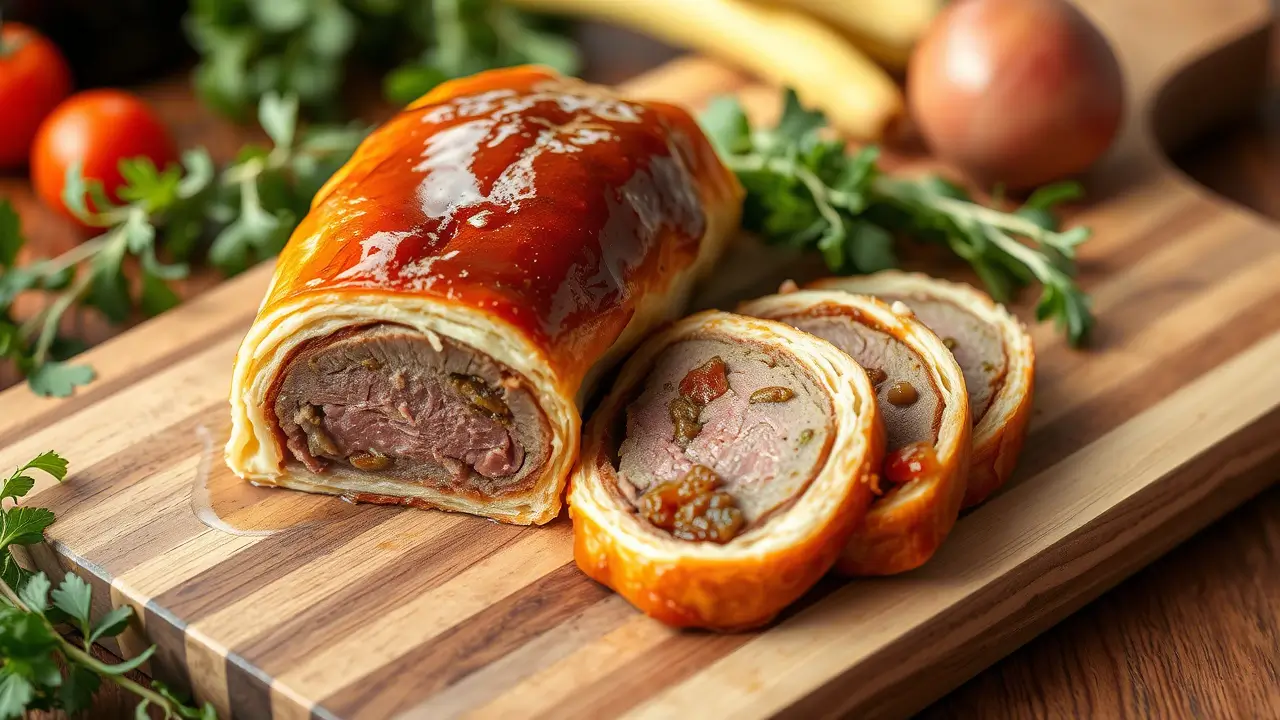What is a Beef Wellington recipe? It’s the culinary equivalent of a perfectly executed Michelin-star dish, but surprisingly, it’s way more achievable than you think! Picture this: a succulent, perfectly-seared beef tenderloin, swathed in a delicate duxelles (a mushroom paste, for the uninitiated), then lovingly enveloped in a crisp, flaky puff pastry. The result? A symphony of flavors and textures that will leave your taste buds singing. Creamy, flavorful, juicy, Beef Wellington is all of that and more.
I remember the first time I attempted Beef Wellington. Let’s just say, it wasn’t pretty. My puff pastry resembled a deflated balloon, and the beef was… well, let’s just say I learned a valuable lesson about proper pastry handling! But don’t let my initial culinary catastrophe deter you. This recipe is designed to demystify this seemingly intimidating dish, making it accessible to even the most novice home cooks. It’s surprisingly simple, quicker than you might imagine, and absolutely perfect for impressing family and friends (or just treating yourself!).
“For a completely different but equally satisfying beef dish, check out our Best Beef Enchilada Recipe: 5 Simple Steps for a comforting Mexican-inspired meal that’s perfect when you’re craving something warm and flavorful.
This Beef Wellington recipe is special because it’s a celebration of classic French techniques but presented in a way that’s completely manageable at home. We cut through the fancy jargon and focus on creating a delicious meal without the hours of prep time often associated with this dish. Unlike our other popular recipe, the slow-cooked lamb shank (which admittedly is divine!), this Beef Wellington offers a faster, more elegant, yet equally satisfying option for a special occasion dinner or a truly impressive weeknight meal. Get ready to wow your loved ones! Prepare to be amazed by how simple yet spectacular this dish really is.
What is Beef Wellington? A Name as Rich as the Dish Itself
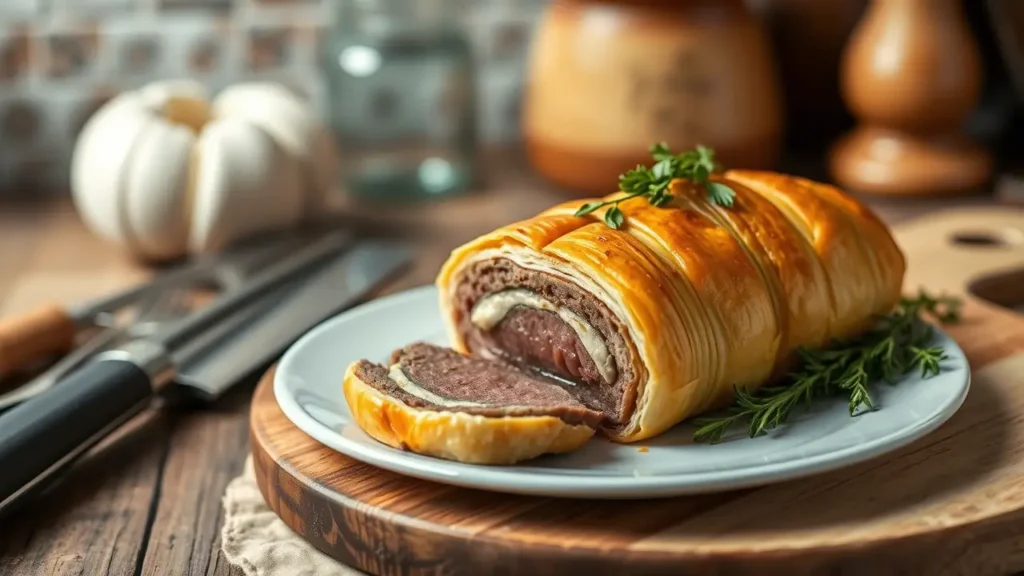
So, Beef Wellington… sounds rather grand, doesn’t it? Why “Wellington?” Is it named after a particularly well-dressed bull? Or perhaps a prize-winning cow with a flair for the dramatic? The truth, my friends, is far more intriguing (and slightly less bovine!). Legend has it that the dish was named after the Duke of Wellington, a renowned British military leader. While the exact origin remains shrouded in a delicious mystery, it’s a testament to the dish’s rich history and enduring popularity. The way to a man’s heart is through his stomach, they say, and with this Beef Wellington, you’ll surely capture the hearts (and stomachs!) of everyone at your table. Ready to embark on this culinary adventure? Let’s get cooking!
Why You’ll Love This Beef Wellington Recipe
This Beef Wellington recipe boasts a few key advantages that make it a must-try:
The Star of the Show: Perfectly Cooked Beef: The main highlight is undeniably the perfectly cooked beef tenderloin. We’re talking melt-in-your-mouth tenderness with a beautifully seared exterior – a masterpiece of texture and flavor. Imagine that first juicy bite, the rich, savory beef contrasting with the earthy mushrooms and the delicate crispness of the pastry.
Budget-Friendly Feast: Making Beef Wellington at home is significantly more cost-effective than ordering it at a restaurant. You control the quality of the ingredients and avoid the hefty markups. This allows you to enjoy a luxurious meal without breaking the bank. Think of it as an investment in your culinary skills and a delicious reward for your efforts.
Flavor Explosion: The flavorful duxelles, a mixture of finely chopped mushrooms sautéed with shallots and garlic, adds an umami depth that perfectly complements the richness of the beef. The puff pastry, wonderfully golden and flaky, provides a satisfying textural contrast, adding a touch of elegance to the entire dish. This isn’t just dinner; it’s an experience for the senses! Compared to simpler beef recipes, this dish offers a more sophisticated, layered flavor profile. You can explore variations on our simpler Beef Stroganoff recipe for other delicious beef options.
Ready to experience the magic of homemade Beef Wellington? Let’s get started!
How to Make Beef Wellington: A Step-by-Step Guide
Quick Overview:
This Beef Wellington recipe transforms what’s traditionally considered an intimidating, restaurant-level dish into an achievable centerpiece meal that home cooks can confidently prepare. By streamlining the complex techniques and reducing the preparation time typically associated with this classic French-inspired dish, we’ve made it possible for both novice and experienced cooks to create something truly spectacular without the usual stress or extensive time commitment.
The simplified method maintains all the hallmarks of a perfect Beef Wellington: tender, perfectly seasoned beef tenderloin that’s seared to lock in juices, a rich pâté or mushroom duxelles layer that adds incredible depth of flavor, and that signature golden, flaky puff pastry exterior that’s as beautiful as it is delicious. Despite the elegant presentation and restaurant-quality results, this version requires only about an hour of hands-on cooking time, making it practical enough for a special weeknight dinner yet impressive enough for holiday gatherings or dinner parties.
What sets this approach apart is its accessibility – no need for specialized equipment or advanced culinary skills. The step-by-step process guides you through each stage, from preparing the flavorful mushroom mixture to wrapping and baking the Wellington to golden perfection. The end result is a show-stopping dish that delivers restaurant-quality taste and presentation, with succulent, medium-rare beef surrounded by aromatic herbs and encased in pastry that’s beautifully golden and crisp, guaranteed to impress your guests while proving that sophisticated cooking is well within reach.
Key Ingredients for Beef Wellington:
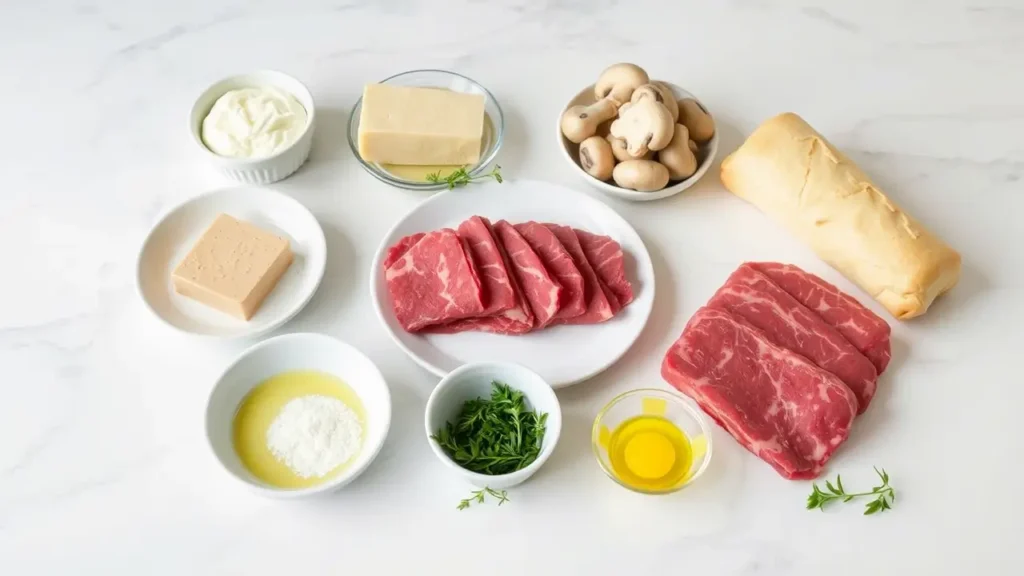
- 1 (1.5-2 lb) beef tenderloin, trimmed
- 1 tbsp olive oil
- Salt and freshly ground black pepper
- 1 tbsp butter
- 1 lb cremini mushrooms, finely chopped
- 2 shallots, finely chopped
- 2 cloves garlic, minced
- 1/4 cup dry sherry (optional)
- 1/4 cup Dijon mustard
- 1 package (14.1 oz) refrigerated puff pastry, thawed
- 1 egg, beaten
Step-by-Step Instructions:
Sear the Beef: Preheat oven to 400°F (200°C). Season the beef tenderloin generously with salt and pepper. Heat olive oil in an oven-safe skillet over high heat. Sear the tenderloin on all sides until nicely browned (about 2-3 minutes per side). This step is crucial for developing flavor and a delicious crust.
Prepare the Duxelles: In the same skillet, melt the butter over medium heat. Add the shallots and cook until softened (about 3 minutes). Add the mushrooms and garlic, and cook until the mushrooms have released their moisture and are nicely browned (about 8-10 minutes). If using, stir in the sherry and cook for another minute until slightly reduced. Season with salt and pepper. Set aside to cool.
Assemble the Wellington: Spread the Dijon mustard evenly over the seared beef tenderloin. Spread the cooled duxelles evenly over the mustard. Carefully unroll the puff pastry on a lightly floured surface. Place the beef tenderloin in the center of the pastry. Fold the pastry over the beef, tucking in the edges to create a neat parcel. Crimp the edges to seal.
Bake the Wellington: Brush the pastry with the beaten egg. This will give it a beautiful golden brown finish. Place the Wellington seam-side down on a baking sheet. Bake for 25-30 minutes, or until the pastry is golden brown and the internal temperature of the beef reaches 130-135°F (54-57°C) for medium-rare.
Rest and Serve: Remove the Wellington from the oven and let it rest for 10-15 minutes before slicing and serving. This allows the juices to redistribute, resulting in a more tender and flavorful beef.
What to Serve Beef Wellington With
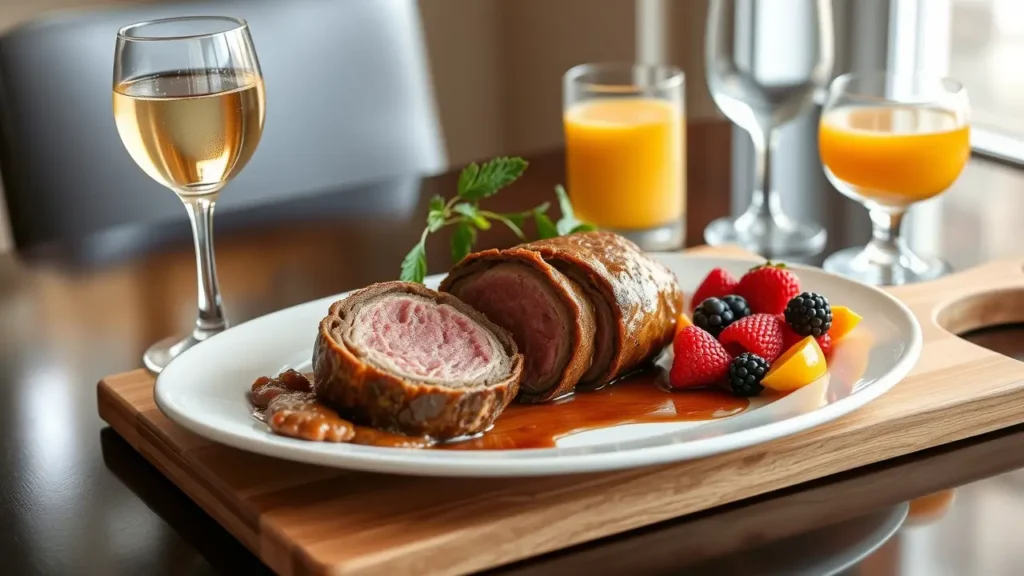
Beef Wellington is a sophisticated dish that deserves equally elegant accompaniments to create a complete dining experience. The key is balancing the rich, complex flavors of the Wellington with sides that complement rather than compete, ensuring each element enhances the overall meal.
Roasted Asparagus serves as an ideal vegetable accompaniment, with its bright, slightly sweet flavor providing a fresh contrast to the buttery richness of the puff pastry and beef. The elegant spear presentation mirrors the refined nature of the main dish, while the tender-crisp texture adds a delightful contrast to the Wellington’s smooth interior.
Creamy Mushroom Sauce creates a harmonious classic pairing, echoing the earthy mushroom duxelles already nestled against the beef. This luxurious sauce adds an extra layer of umami depth and silkiness that bridges the flavors between the meat and pastry, making each bite even more indulgent.
Red Wine Reduction offers an intense, concentrated flavor bomb that amplifies the beef’s savory characteristics. The reduced wine’s complexity – with its concentrated fruit, tannins, and subtle acidity – cuts through the richness while adding a sophisticated sauce element that’s both beautiful and delicious.
Simple Salad provides essential brightness and freshness to cleanse the palate between bites. A minimalist approach with mixed greens, perhaps with shaved vegetables and a light vinaigrette, offers necessary acidity and crunch that prevents the meal from feeling too heavy while maintaining the elegant theme.
For beverages, a full-bodied red wine like Cabernet Sauvignon or Merlot creates the perfect liquid companion. These wines’ robust tannins complement the beef’s richness, while their complex flavor profiles, from dark fruit notes to subtle oak influences, harmonize beautifully with both the meat and the wine reduction sauce, tying the entire meal together in perfect balance.
Top Tips for Perfecting Beef Wellington
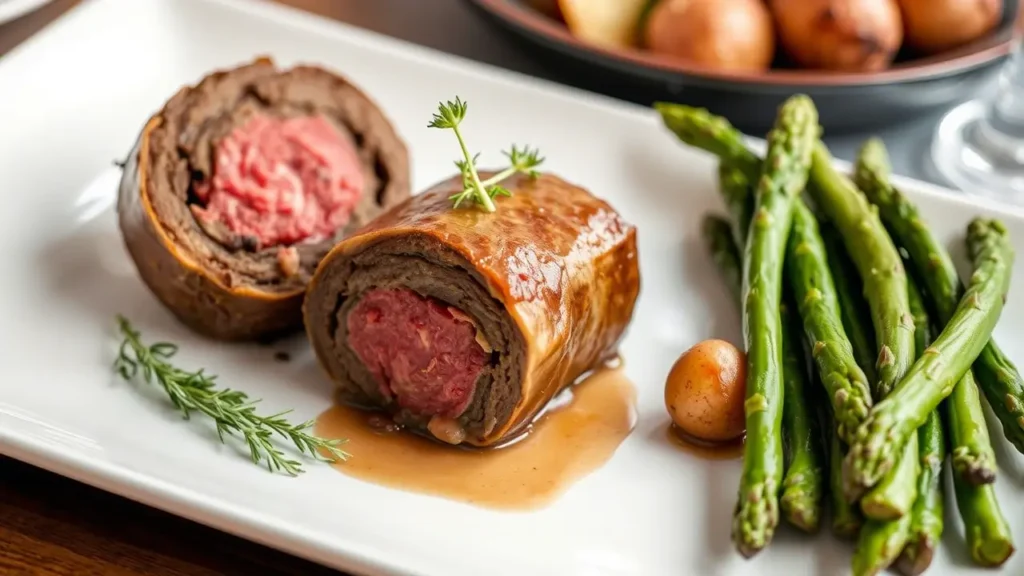
- Don’t Overcrowd the Pan: When searing the beef, ensure you have enough space in the pan to allow for even browning. Overcrowding will result in steaming instead of searing.
- Properly Cool the Duxelles: Allowing the duxelles to cool completely before assembling the Wellington is crucial to prevent the pastry from becoming soggy.
- Use High-Quality Puff Pastry: Investing in good quality puff pastry will make a noticeable difference in the final result.
- Don’t Overbake: Overbaking will dry out the beef and make the pastry tough. Use a meat thermometer to ensure the beef is cooked to your desired doneness.
- Egg Wash is Key: Brushing the pastry with egg wash not only adds a beautiful sheen but also helps it brown evenly.
Storing and Reheating Tips
Beef Wellington is best served fresh, but leftovers can be stored in the refrigerator for up to 3 days. Allow the Wellington to cool completely before wrapping it tightly in plastic wrap, then placing it in an airtight container.
For a detailed guide on making this classic dish, visit Simply Recipes’ comprehensive Beef Wellington Recipe , which includes step-by-step instructions and helpful tips for perfecting this elegant meal.
To reheat, slice the Wellington and place the slices on a baking sheet. Bake at 350°F (175°C) for 10-15 minutes, or until heated through. You can also reheat it in a microwave, but this method may result in a slightly less crispy pastry. Freezing is not recommended, as it can significantly affect the texture of the puff pastry.
Frequently Asked Questions (FAQs)
Q: Can I use a different type of mushroom in the duxelles?
A: Absolutely! Shiitake, oyster, or a combination of mushrooms would work well.
Q: What if my puff pastry tears while assembling the Wellington?
A: Don’t worry! Simply patch any tears with small pieces of pastry and continue assembling.
Q: How can I tell if the beef is cooked to the right temperature?
A: Use a meat thermometer to ensure the internal temperature reaches your desired doneness. 130-135°F (54-57°C) is ideal for medium-rare.
Q: Can I make the duxelles ahead of time?
A: Yes! The duxelles can be made a day or two in advance and stored in the refrigerator. This will save you time on the day of cooking.
Did You Try Our Recipe?
There are no reviews yet. Be the first one to write one.

Beef Wellington
Ingredients
Method
- Preheat oven to 400°F (200°C).
- Season the beef tenderloin generously with salt and pepper.
- Heat olive oil in an oven-safe skillet over high heat. Sear the tenderloin on all sides until nicely browned (about 2-3 minutes per side).
- In the same skillet, melt the butter over medium heat.
- Add the shallots and cook until softened (about 3 minutes).
- Add the mushrooms and garlic, and cook until the mushrooms have released their moisture and are browned (about 8-10 minutes).
- If using, stir in the sherry and cook for another minute until slightly reduced.
- Season with salt and pepper. Set aside to cool.
- Spread the Dijon mustard evenly over the seared beef tenderloin.
- Spread the cooled duxelles evenly over the mustard.
- Carefully unroll the puff pastry on a lightly floured surface.
- Place the beef tenderloin in the center of the pastry.
- Fold the pastry over the beef, tucking in the edges to create a neat parcel.
- Crimp the edges to seal.
- Brush the pastry with the beaten egg.
- Place the Wellington seam-side down on a baking sheet.
- Bake for 25-30 minutes, or until the pastry is golden brown and the internal temperature of the beef reaches 130-135°F (54-57°C) for medium-rare.
- Remove the Wellington from the oven and let it rest for 10-15 minutes before slicing and serving.

